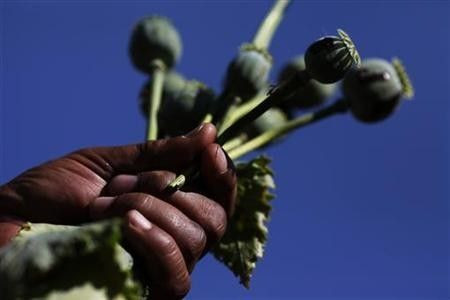India’s Punjab State Engulfed In Drug Epidemic

As India convulses over the ramifications of the Delhi gang rape of a young woman who subsequently died, the northwestern province of Punjab finds many of its young men ensnared in a paralyzing drug epidemic.
While Punjab is one of the wealthiest parts of India, its high unemployment rate, slowing economy and proximity to Pakistan and Afghanistan makes its young men highly vulnerable to addiction to illegal narcotics, particularly opium, hashish and heroin. In the past two decades, Punjab has become a principal smuggling route for drugs from Afghanistan ultimately destined for Europe, but much of the product has found an eager market in India.
Attempts by the Indian government to seal the border with Pakistan have only pushed up the price of drugs, including heroin, forcing addicts to gravitate toward cheaper over-the-counter pharmaceuticals that produce a similar high. These latter drugs are almost entirely manufactured within India itself.
According to a report in the Washington Post, the town of Maqboolpura, outside Amritsar, near the Pakistani border, has been so devastated by the deadly scourge of drug abuse it has earned the sobriquet “the place of widows.”
"The situation here is pathetic, pathetic," local school director Brij Bedi told the BBC.
"We encounter drug addicts in the daytime. Sometimes, they become very violent also. They're drunk or have taken drugs. Sometimes they try to abuse also. ... The police know exactly who sells the drugs, but the tragedy is they are helpless. They are gutless people."
Drug seizures have increased by 200 percent over just the past two years in Punjab, which accounts for more than 50 percent of all heroin seized by Indian police annually.
“[Drugs are] a very big problem, and our youth is being engulfed in it,” sociologist Ravinder Singh Sandhu told the Post. “Punjabis are very aspirational people, and when their aspirations are not fulfilled, then they are depressed.”
"I started taking [drugs] when I was at school," a young addict, a student from the Punjabi market town of Tarn Taran, explained to the BBC. "Smack [heroin] is easily available at all the schools and colleges in the border area. I reckon that most of the 18-to-25-year-olds here take drugs.”
The local government estimated in 2009 that two-thirds of all rural households in Punjab had at least one drug addict.
Official corruption worsens the problem -- anecdotal evidence strongly indicates that Indian police and lawmakers are deeply complicit in both drug smuggling and distribution, netting millions of dollars in ill-gotten proceeds. For example, in 2009, Saji Mohan, a senior police narcotics chief from Chandigarh, the capital of Punjab, was arrested in Mumbai and charged with selling heroin.
“It’s basically the police who are smuggling half the drugs in the state,” one unidentified man told the Post.
“If they confiscate 100 packets, police show 50 to the press and let the other 50 back into the market.”
In tandem with this surge in drug abuse, an increasing number of Punjabi addicts are injecting heroin instead of smoking it, leading to a spike in HIV/AIDS infections.
"It's as if we're sitting on a time bomb that can explode at any time," Dr. J.P.S. Bhatia, who operates a rehabilitation clinic in the city of Amritsar, told BBC.
"It [the rate of addiction] is definitely on the rise, and it is increasing so much that the scenario at the moment is that of an epidemic.”
Bhatia suggests that the prosperity Punjab is renowned for (at least prior to the recent economic sluggishness) may be part of the problem.
"The middle class and the affluent are the worst victims of this [drug] crisis," he said.
"They are not laborers who don't have to worry about getting up in the mornings. They can sit at home taking heroin, while someone else does their work.”
Punjab also has a very macho culture, very prone to consumerism, violence and showing off.
“It’s a ready-made market for drugs,” former addict Navneet Singh told Agence France-Presse.
“What does the [typical] Punjabi do when he gets rich? He buys an SUV, a gun, and he gets high. Then as time passes and you get addicted, you will do anything to support the habit.”
Rates of drug-related crime in Punjab are almost 10 times the national average for India, AFP reported, citing police records.
Last April, India’s First Post newspaper described Punjab’s drug problem as “gargantuan.”
"Punjab is teetering on the edge of an extraordinary human crisis, with an inordinately large number of youngsters hooked on ... marijuana, opium and heroin, in addition to imbibing a range of prescriptive tablets,” said Raj Pal Meena, the former head of the state's Anti-Narcotics Task Force.
With a population of about 28 million, only 51 drug rehabilitation centers exist in Punjab, currently treating about 5,000 addicts, according to the Hindustan Times.
”The number of addicts admitted in each center was 80 to 85 [until] 2007 and has now gone up to 190 in some centers,” Amanjeet Singh, president of the Punjab State Drug Counseling and Rehabilitation Centers Union, told the paper.
Drugs are also a serious problem in Punjabi prisons. About 62 percent of the province’s inmates are estimated to be drug abusers, and one-fifth are hard-core addicts. As with other institutions in Punjab, the jail system is woefully ill-equipped to cope with incarcerated drug addicts.
"It's a drug hurricane," Harjit Singh, secretary of Punjab’s Department of Social Security, gravely warned India Today. "We are in danger of losing our young generation."
© Copyright IBTimes 2024. All rights reserved.





















